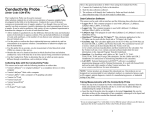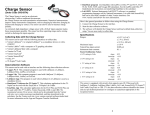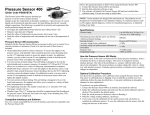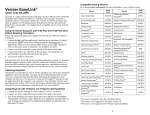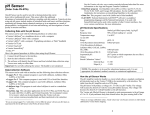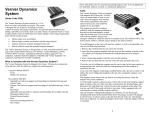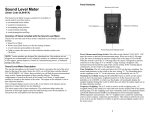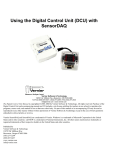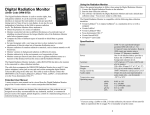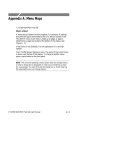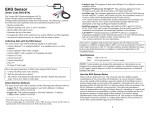Download Instrumentation Amplifier
Transcript
Data-Collection Software Instrumentation Amplifier (Order Code INA-BTA) Our Instrumentation Amplifier is used to condition signals to be compatible with Vernier interface products. The amplifier provides the necessary gain and offset to allow you to connect a wide variety of measurement equipment to your interface and electronically collect, store, and analyze the data. Although you may calibrate your software to display otherwise, your interface unit can only measure a potential difference (voltage). Many laboratory instruments produce a voltage which varies as the instrument reading changes. Examples include gas chromatographs, spectrophotometers, light meters, and sound meters. If you are familiar with electronics, you may be able to go inside the instrument and find out where to measure this voltage signal. Some instruments seen have chart recorder terminals that are designed for just this kind of thing. Test the voltage range of this signal. If the voltage happens to vary over a range that matches your interface, then the signal can be fed directly to the interface and monitored by the software. More likely, the voltage signal will need to be amplified before it can be monitored. Collecting Data with the Instrumentation Amplifier This sensor can be used with the following interfaces to collect data. Vernier LabQuest® 2 or original LabQuest as a standalone device or with a computer Vernier LabQuest Mini with a computer Vernier LabPro® with a computer or TI graphing calculator Vernier Go!®Link Vernier EasyLink® Vernier SensorDAQ® CBL 2™ TI-Nspire™ Lab Cradle Here is the general procedure to follow when using the Instrumentation Amplifier. 1. Connect the Instrumentation Amplifier to the interface. 2. Start the data-collection software.1 3. The software will identify the Instrumentation Amplifier and load a default datacollection setup. You are now ready to collect data. 1 If you are using Logger Pro 2 with either a ULI or SBI, the sensor will not auto-ID. Open an experiment file for the Instrumentation Amplifier in the Probes & Sensors folder. This sensor can be used with an interface and the following data-collection software. Logger Pro 3 This computer program is used with LabQuest 2, LabQuest, LabQuest Mini, LabPro, or Go!Link. Logger Lite This computer program is used with LabQuest 2, LabQuest, LabQuest Mini, LabPro, or Go!Link LabQuest App This program is used when LabQuest 2 or LabQuest is used as a standalone device. EasyData App This calculator application for the TI-83 Plus and TI-84 Plus can be used with CBL 2™, LabPro, and Vernier EasyLink. We recommend version 2.0 or newer, which can be downloaded from the Vernier web site, www.vernier.com/easy/easydata.html, and then transferred to the calculator. See the Vernier web site, www.vernier.com/calc/software/index.html for more information on the App and Program Transfer Guidebook. DataMate program Use DataMate with LabPro or CBL 2™ and TI-73, TI-83, TI-84, TI-86, TI-89, and Voyage 200 calculators. See the LabPro and CBL 2™ Guidebooks for instructions on transferring DataMate to the calculator. DataQuest™ Software for TI-Nspire™ This calculator application for the TI-Nspire can be used with the EasyLink or TI-Nspire Lab Cradle. LabVIEW National Instruments LabVIEW™ software is a graphical programming language sold by National Instruments. It is used with SensorDAQ and can be used with a number of other Vernier interfaces. See www.vernier.com/labview for more information. This sensor is equipped with circuitry that supports auto-ID. When used with LabQuest 2, LabQuest, LabQuest Mini, LabPro, Go! Link, SensorDAQ, TI-Nspire™ Lab Cradle, EasyLink, or CBL 2™, the data-collection software identifies the sensor and uses pre-defined parameters to configure an experiment appropriate to the recognized sensor. How the Instrumentation Amplifier Works The amplifier is a monolithic instrumentation amplifier with variable gain and offset settings. An instrumentation amplifier contains precision feedback components and circuitry that is necessary for small signal amplification. The Instrumentation Amplifier does three primary tasks: Provides six different gain settings to amplify small signals to levels appropriate for our interfacing equipment. Offsets the voltage so it is always in the range of 0 to 3.5 volts. This allows the amplifier to be used with negative signals even though some of our interfaces only use 0-5 V inputs. Provides filtering of high frequency signals. Wires that connect the instrument to the amplifier are prone to pick up electrical noise much like a radio antenna. By filtering out these signals, only the data of interest are left. When set to the 20 mV, 200 mV and 1 V positions, the amplification is set to 150, 15, and 3 respectively. The difference in voltage at the red and black terminal is amplified and output with reference to ground. 2 When set to 20 mV, 200 mV, and 1 V setting, the amplification is set to 75, 7.5, and 1.5 respectively. The difference in voltage at the red and black terminal is amplified and output with reference to 1.85 V. Amplify an Instrument’s Chart Recorder Output Many lab instruments provide a low voltage output designed for interfacing to a chart recorder. You may use these outputs with the Instrumentation Amplifier to interface to a computer. This graph shows the output of a gas chromatograph processing a sample of fatty acids dissolved in toluene solvent.2 Specifications Gain settings: 150, 75, 7.5, 15, 3, and 1.55% Linearity: 1% Power: 2.5 mA @ 5VDC Frequency Response: 0–10kHz (f3dB) Impedance : 1MΩ to ground Calibration values +/-1V slope: 0.471648 intercept: –0.8584 +/-200mV slope: 0.117912 intercept: –0.2146 +/-20mV slope: 0.013181 intercept: –0.02399 0–1V slope: 0.308642 intercept: 0 0–200mV slope: 0.062617 intercept: 0 0–20mV slope: 0.006636 intercept: 0 Use as a Current Meter Tips for Using the Instrumentation Amplifier with a Gas Chromatograph If your voltage readings are noisy, you should connect the Earth ground of the Gas Chromatograph to the black post on the end of the Instrumentation Amplifier box where the sensor cable is located. Connecting the Earth ground in this way should reduce or eliminate any electronic noise. Also, keep in mind that Logger Pro software and LabQuest App both have Peak Integration tools that can be used to integrate and quantify GC peaks. Once you have collected GC data, you can simply choose Peak Integration from the Analyze menu. On this dialog, you can select and integrate peaks one at a time. NOTE: Vernier products are designed for educational use. Our products are not designed nor recommended for any industrial, medical, or commercial process such as life support, patient diagnosis, control of a manufacturing process, or industrial testing of any kind. 2 Data collected using an Instrumentation Amplifier and GOW-Mac Series 350 Gas Chromatograph. 3 The Instrumentation Amplifier can be used to monitor current instead of voltage. By placing a resistor between the terminals, the voltage amplified becomes proportional to the current according to I = (V/G)/R where V is the voltage read, G is the gain setting of the amplifier, and R is the resistor value. To monitor current in a circuit, you want to choose a small resistor value; for example 0.1Ω or 1Ω resistor with a rating of at least 1W. For monitoring a current output device, you will need to choose a termination resistor that is appropriate for that device (call for details or consult the manufacturers specifications). For best accuracy, perform a calibration using an open circuit and a known current source. Vernier also sells a Current Probe (order code: DCP-BTA), which has a range of 600 mA. Warranty Vernier warrants this product to be free from defects in materials and workmanship for a period of five years from the date of shipment to the customer. This warranty does not cover damage to the product caused by abuse or improper use. Vernier Software & Technology 13979 S.W. Millikan Way Beaverton, OR 97005-2886 Toll Free (888) 837-6437 (503) 277-2299 FAX (503) 277-2440 [email protected] www.vernier.com Rev 6/5/2012 Logger Pro, Logger Lite, Vernier LabQuest 2, Vernier LabQuest, Vernier LabQuest Mini, Vernier LabPro, Go! Link, Vernier EasyLink and other marks shown are our trademarks or registered trademarks in the United States. TI-Nspire, CBL 2, TI-GRAPH LINK, and TI Connect are trademarks of Texas Instruments. All other marks not owned by us that appear herein are the property of their respective owners, who may or may not be affiliated with, connected to, or sponsored by us. Printed on recycled paper. 4



